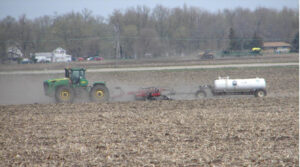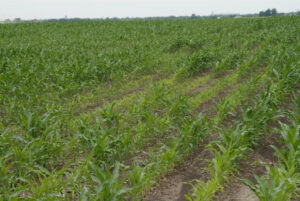Key Points
- Fertilization method, application timing, and fertilizer cost should be evaluated to minimize nitrogen (N) loss while meeting crop needs.
- All N fertilizer formulations have the potential for loss. Understanding these loss mechanisms can help farmers make informed choices for each unique situation.
- Denitrification, leaching, and volatilization are three processes that can lead to N loss from a pre-plant application.
Potential Nitrogen Loss
Denitrification
Denitrification is the process by which soil bacteria that thrive in water-saturated (anaerobic) soils convert nitrate into gaseous forms of N. This bacterial conversion of nitrate into nitrogen gas can result in as much as 5% nitrate loss per day. Losses will be higher with warmer soil temperatures.
Leaching
Leaching occurs when nitrate moves downward in the soil profile, out of the root zone, due to excessive rainwater or irrigation. Fertilizers that contain urea ammonium nitrate (UAN) are highly susceptible to leaching, especially when applied to coarse-textured soils.
Volatilization
Volatilization can occur when urea-based fertilizers are surface-applied and not incorporated. Urease enzymes in the soil and plant residue convert urea to free ammonia gas. Up to 20% of urea-based N can volatilize within a week of application, especially on warm sunny days with moist soil surface conditions.
Volatilization can be inhibited or delayed through the use of products such as nitrification inhibitors, urease inhibitors, and polymer-coated urea.

(Figure 1). Anhydrous ammonia applications in the spring.
Nitrogen Application Timing
Fall applications have the greatest risk of N loss. Anhydrous ammonia is recommended for situations in which fall N applications are preferred, because it has the lowest loss risk of any N fertilizer. Anhydrous ammonia should be applied with a nitrification inhibitor when soil temperature is less than 50 °F (10 °C). A nitrification inhibitor works by slowing down the conversion of ammonium to nitrate in the soil, reducing the potential risk of N loss.
Spring pre-plant applications are generally preferable due to their lower potential for N loss and improved timing relative to rapid plant N uptake. However, spring can also be a time of large potential N loss due to wet soils. If N is applied more than two weeks prior to planting, anhydrous ammonia is recommended to help reduce the risk of loss. Nitrogen loss potential due to leaching is highest when applied to sandy or coarse-textured soils.
Strip till pre-plant fertilizer applications can apply both a N source and a second fertilizer, or combination of fertilizers, six to eight inches deep. This can be done in the fall or in the spring prior to planting. This one-trip tillage operation tills a narrow strip to prepare a seed bed while positioning pre-plant fertilizer several inches below the seed slice where the seed will be placed at planting. Placing a band of fertilizer into the future root zone increases plant utilization, especially if the soil has very low nutrient availability.
At-planting or in-season sidedress applications may be required if soil conditions or workload prevent a pre-plant application of N fertilizer, pushing the N application into the at-planting or in-season sidedress window. If such an application is required, note that any N source can be susceptible to denitrification if the soil is saturated after the application and after the N has been converted to nitrate by soil organisms. If available, fertigation using an overhead sprinkler irrigation can also effective.
Caution – Avoid placing high rates of N or potassium fertilizer in direct contact with seed to prevent potential seedling injury from salt burn.
Nitrogen Sources and Application
Ammonium and nitrate are the two forms of N used by plants. Other forms of N must be converted by soil organisms to one of these forms before plants can use them, and so the N source should be considered when determining which application method to use.
Anhydrous ammonia is the densest nitrogen source. All other nitrogen fertilizer sources are made from anhydrous ammonia, with additional manufacturing processes that reduce the concentration and typically increase the cost per unit of N (though cost can
be affected by seasonal supply and demand). However, all other N sources are generally easier to store and apply, and are safer to handle than anhydrous ammonia.
| Table 1. Nitrogen (N) source and application. | ||||||
| N-Source Analysis | Common Name | N Form | Time of Application | Advantage of Product | Primary Method of N Loss | Use with N Stabilizer/Inhibitor |
| 82-0-0 | Anhydrous Ammonia | Gas/Liquid | Fall, Pre-plant, Sidedress | Nitrogen Dense | Volatilization | Yes |
| 46-0-0 | Urea | Dry Pellet | Pre-Plant, Band | Good Storage and Handling | Volatilization/ Leaching | Yes |
| 28/32-0-0 | Urea Ammonium Nitrate (UAN) | Liquid | Pre-plant, Sidedress | Relatively Easy to Handle and Apply | Volatilization/Leaching | Yes |
Determining the Nitrogen Application Rate
The rate of N applied is an important variable, because of the related economic and environmental issues. Determining the proper N application rate can be difficult due to the effects of temperature and precipitation on the release of N (mineralization) from the soil over time and after an application, and because microbial activity releases more N under good corn-growing conditions.
Before determining the amount of N to apply, the producer must:
- Estimate the amount of N already in the soil that will be available for corn crop use
- Determine the total N needed for the expected crop yield
- As yield goals increase, the amount of N required will also increase
Crop nitrogen needs and the corresponding N applications must be calculated every year and for every field. A common calculation to determine the total N needed for an acre of corn is multiplying the yield goal for the projected crop year by a factor of 1.0 to 1.2 pounds of N per bushel per acre, and applying N based upon yield goals and soil test levels has been a common method used in western corn growing areas.
Alternatively, several universities in the Corn Belt recommend using a “maximum return to N” (MRTN) formula to determine an appropriate N application rate. These calculations are made for a single N cost and corn price combination; different price combinations can be placed on the same graph to compare additional N cost and corn price combinations. Different states and different crop rotations are used to formulate different MRTN graphs for those situations. For more information on MRTN calculations, see the Corn Nitrogen Rate Calculator at https://www.cornnratecalc.org/ or the Ontario Corn Nitrogen Calculator at http://www.gocorn.net/.
Consider all N sources when making application decisions, including any previous legume crops and manure applications, and credit the N supplied from those sources to reduce the amount of nitrogen fertilizer needed. Using variable rate technology to apply more N in fields or areas of fields where there is greater potential for response can also help increase yield potential.

Figure 2. A growing corn crop that is nitrogen deficient.
